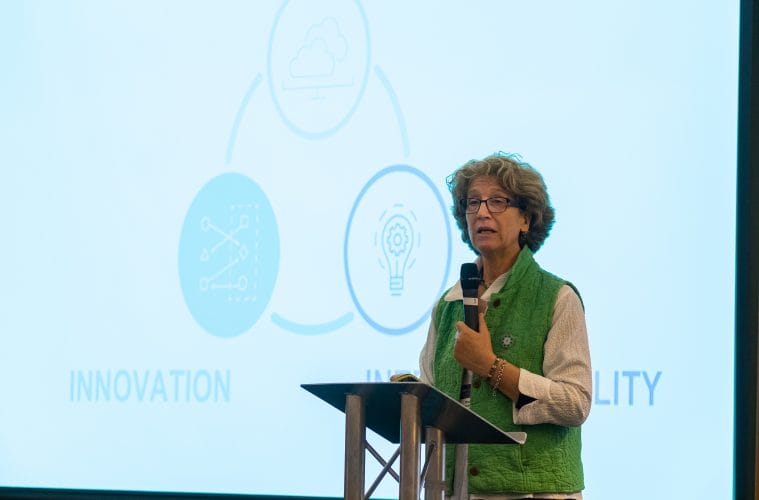The first ever LF Energy Summit was held recently in Edinburgh, Scotland. This event brought together power system engineers with open source developers to start building a community of utilities, TSOs, DSOs, vendors, and other energy leaders dedicated to accelerating the global effort to transform the world’s relationship to energy.
Shuli Goodman is the founder and Executive Director of LF Energy. During her keynote presentation she put a call out for “10,000 developers to electrify the planet.” Wanting to know more I asked her about about the project, its current status and future plans.
Could you please give a brief description of the LF Energy Project?
LF Energy is an umbrella organization formed under The Linux Foundation with the goal of driving new innovation in the power systems sector through open source. LF Energy aims to enable collaborative approaches to building new energy technologies with the end result of de-carbonizing the global economy. The project was started to disrupt an industry to completely re-imagine the way the energy sector functions.
There is a call out for 10,000 developer to electrify the planet, what has the response/interest been to-date?
We are just getting started, but we are grateful to have dozens of developers contributing to our four existing projects. We also have nearly 500 developers who have signed up for our developer mailing list, which is a fantastic sign of the interest in this project so early on. There is still a long way to go, but we are seeing lots of excitement in the industry, and look forward to getting the word out more so more developers join the community.
What organisations are already on-board with the project? Have any Irish providers signed up, if yes, who?
The project started thanks to the leadership of RTE, Europe’s biggest transmission power systems provider, EPRI and ENTSO-E, and we are in fairly advanced discussions with many additional organizations whom we can’t just now name.
In terms of Ireland, we recognize that Ireland has been a leader in pushing for de-carbonization and clean energy, and we look forward to working with many organizations and developers in the country in pursuit of our common goals.
What is the current status of the project?
Currently, we have four active projects under the LF Energy umbrella:
OperatorFabric: A Smart Assistant For System Operators
OperatorFabric is a modular, extensible, industrial-strength and field-tested platform for use in electricity, water, and other utility operations.
– System visualization and console integration
– Precise alerting
– Workflow scheduling
– Remedial action manager
– Historian
– Scripting (ex: Python, JavaScript)
Let’s Coordinate: A Multi-System Technical and Organizational Module Based on OperatorFabric
Let’s Coordinate streamlines organizational and technical communications between operators in power systems (TSOs Regional Security Coordinators, DSOs, etc.).
– Creation, exchange and merging of power grid models
– Coordinated security analysis
– Capacity calculation
– System adequacy forecasting
– Outage planning coordination
– Decision-making workflow
– Historical reference for decision transparency
– Precise alerting
– Workflow scheduling
– Modular and extensible
– Remedial action manager
– Scripting (ex: Python, JavaScript)
PowSyBl: A High-Performance Computing Framework For Grid Simulation and Planning
PowSyBl provides the code building blocks for the simulations and analyses of power systems, for horizons from real-time operation to investment planning
– Grid data model, described with Java classes and possibility to define extensions with plugins
– Data management system
– Importers and exporters for several formats (CIM, CGMES, UCTE…)
– APIs to various computation modules (load-flow, security analysis, short-circuit computation, sensitivity computation, optimizers, AMPL)
– Distribution framework for HPC (tested on a 10,000 cores platform)
– JavaFX user interface framework
– Scripting
– Advanced functions: grid model merging, remedial actions manager
– Modular architecture based on plugins
RIAPS: An Effective Distributed Software Platform for Smart Grid Apps
RIAPS: The Resilient Information Architecture Platform for Smart Grid (RIAPS) provides core infrastructure and services for building effective, secure and powerful distributed Smart Grid applications. Examples include monitoring and control, data collection and analytics, energy management, microgrid control, and protection applications. The RIAPS technology stack features:
– Component-oriented programming model for distributed real-time software running on embedded nodes dispersed throughout the power grid
– Support for low-latency, hard real-time applications via a low-overhead messaging layer
– Services for application management, fault tolerance, security, high-precision time synchronization, distributed coordination
– Uniform device access with support for various industrial protocols
– Development toolkit for developing and deploying apps
– Implementation languages: Python, C++, Simulink/Stateflow, and others
What are your future plans for the project, timescales and goals?
The grid of the future will need AI experts, DL experts, network experts, developers, sysadmins, etc., and creating a community is necessary to ensure there are enough of them. Creating this community is our main goal. We hope to create a very robust training initiative that can help to train developers in power systems, and to train power system engineers in digital technologies.
There is broad agreement in the power sector that digitalization is critical to de-carbonization and transitioning to variable, and renewable energies. There are special issues with power systems because it is both a critical infrastructure and if you don’t understand the physics, a life and limb issue due to the potential to harm or kill, or to destroy property.
Beyond that, we hope to bring more organizations from across industry, utilities and the public sector into LF Energy to collaborate on solving the challenges we all face. Electricity touches every aspect of our economies.
This will also involve bringing more projects into the foundation, whether they are existing, proprietary projects that companies seek to open source, or ones we start from scratch.
The timeline is as soon as possible. The UN’s latest report says we have only 12 years to significantly reduce carbon emissions by 40% to stave off the worst effects of climate change, and we must reach 100% by 2050. There is no time to waste.
Key insights and takeaways:
The urgency for the development of this project needs no explanation as the consequences of climate change and the impact on the planet are reported all too frequently. Shuli’s inspiration for its success are her grandchildren and the generations to come.
- Image and video provided by: The Linux Foundation
More about Irish Tech News
Irish Tech News are Ireland’s No. 1 Online Tech Publication and often Ireland’s No.1 Tech Podcast too.
You can find hundreds of fantastic previous episodes and subscribe using whatever platform you like via our Anchor.fm page here: https://anchor.fm/irish-tech-news
If you’d like to be featured in an upcoming Podcast email us at [email protected] now to discuss.
Irish Tech News have a range of services available to help promote your business. Why not drop us a line at [email protected] now to find out more about how we can help you reach our audience.
You can also find and follow us on Twitter, LinkedIn, Facebook, Instagram, TikTok and Snapchat.

